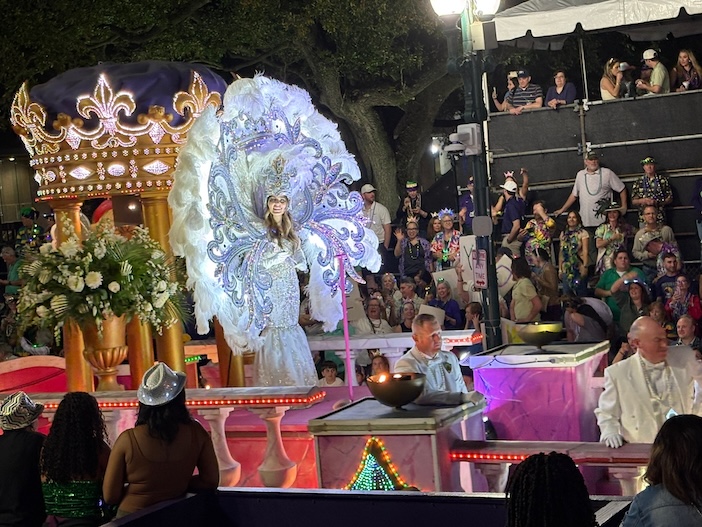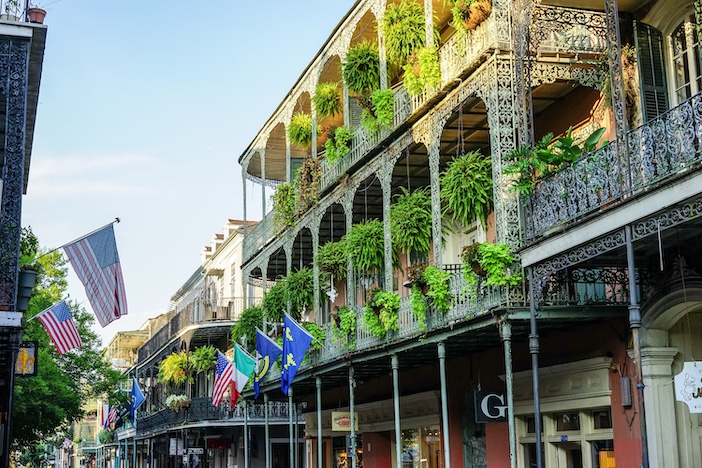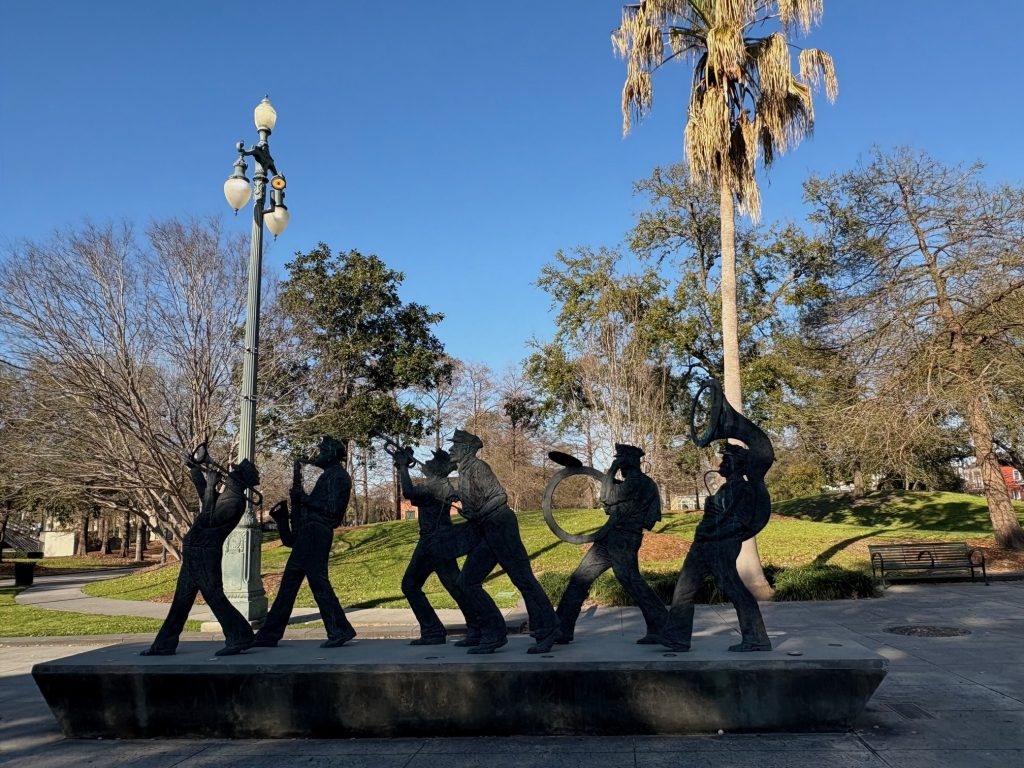Kicking off Lent’s long road of restraint, Jane Wilson joins the festivities of Mardi Gras in its spiritual home…
It’s not a natural phenomenon to see strings of coloured beads littering the sky, heading directly towards you, but it is customary in New Orleans during its Mardi Gras. Frisbees, ‘doubloons’, pralines and socks follow in their wake. Catch them, or dodge them, if you want to survive! Families and tourists line the streets to share the excitement in outfits that would win most fancy-dress contests, although pale in competition with the colours and styles of the floats and their masked riders.
This carnival revelry; the laughter, excitement and social mingling is the hallmark of the Mardi Gras. An event that is part of New Orleans’ DNA. Each float tells a story, paying homage to the traditions of the past while embracing the innovations of the present. Uptown, downtown and out of town, the Mardi Gras touches every corner of this party city and keeps the tradition – and its values – alive, celebrating freedom of character and representing living pieces of history that reflect the unique culture of this mercurial city.

The first parade is recorded to have taken place in 1857, initially celebrated by European Christians to mark the beginning of Lent and the fasting period ahead of Easter. It begins on the Twelfth night and extends until midnight before Ash Wednesday. Mardi Gras is French for Fat Tuesday, effectively the last day of indulgence. The New Orleans event involves some seventy parades, each often lasting hours, organised by social clubs referred to as krewes. Several modern “super krewes” are well known for holding large parades and events (often featuring celebrity guests), such as the Krewe of Bacchus, Krewe of Orpheus as well as the Zulu Social Aid & Pleasure Club, which tend to head to the streets over the last few days.
Not to be missed is the backstreet experience in the oldest African-American neighbourhood in the US. Here, in the early hours on Mardi Gras morning, the Mardi Gras Indians march in costumes of the North Side Skull & Bones Gang to wake up the neighbourhood and prepare the streets. It’s an authentic, sombre experience with a rather dark atmosphere.

For the more fortunate, the views and perspective of this annual spectacle is unique as a rider on a float. A huge amount of organisation and time is involved in this. Firstly, the costumes, vivid and lustrous with matching masks are made for each of the many riders. The line-up of floats is a sight to be seen, all bedecked in elaborate designs, colour palettes and statuettes with tractors attached, likened to a beauty pageant, a contest of wagons. Riders are harnessed into place but not before climbing over boxes piled high with gift throws, (a multi-million business in itself). Once on the official parade, mask-wearing is obligatory until the return to the start point, where yet another party is in full swing.
Positioned next to the Mississippi River is the vast Mardi Gras World, a warehouse where the magic of the Mardi Gras is in the making as a year-round industry. Here artists, sculptors and even the robot Pixi are busy crafting over 500 floats, bringing characters to life in a range of materials from paper mache, clay and fibre glass. It’s like a sculpture wonderland of figures, from a styrofoam Shrek to King Kong, many remodelled and reused. Mardi Gras World started as Kern Studios in 1932 when the first mule-drawn float was built on the back of a garbage wagon, now floats feature multi-sections that can stretch up to 200 feet long, complete with hydraulic moving parts, LED lighting, and pyrotechnic effects.

One area the floats can’t make it, on account of its narrow streets, is the historic French Quarter. Founded as a military-style grid of seventy squares in 1718 by Jean Baptiste Le Moyne de Bienville, the French Quarter made up the original city and is now designated a National Historic Landmark. The streets may be too narrow for the floats, but it remains the epicentre of the party. And everyone can get a piece of the action.
The architecture lends itself to partying with decorated balconies such as the Cornet Restaurant which has the biggest and brightest second floor gallery on Bourbon Street and ideal for throwing beads down to hopeful party-goers. Below, jazz musicians play on the pavements, in the bars and clubs. The iconic wrought iron balconies, derived from the Spanish, have shaped the architectural aesthetic of the city’s French Quarter. And to preserve their splendour, there’s a tradition of “Greasing the Poles” which involves treating the structures to deter overzealous revellers from shimmying up to the coveted balcony space.

Mardi Gras or not, at any time of year, the distinctive sound of jazz seems to bubble up from the streets, with trumpets blaring, blows of a horn, a crash of the cymbal laced with vocals, forming the rich bass band culture. Jazz was born in New Orleans although its roots derive from the musical traditions of Europe and Africa, representing the artistic expression of dreams and destiny. It’s easy to imagine the jazz funerals and slow shuffle march as portrayed in Live & Let Die. Born in New Orleans, Louis Armstrong’s legendary gift of jazz was instrumental in bringing fame and fortune with an airport and 32-acre park dedicated to him. Visit the New Orleans Jazz Museum which celebrates the history of jazz music and Preservation Hall, a jazz venue in the French Quarter famous for acoustic and authentic jazz concerts.
Another tradition of New Orleans still practiced, Voodoo still holds a mysterious fascination. It was regarded as a religion connected to nature, spirits, and ancestors especially when followers, fleeing Haiti, moved to New Orleans, after a slave revolt in 1791. The famous voodoo queen was Marie Laveau, a legendary practitioner is buried in St. Louis Cemetery No.1. Today Voodoo practices include readings, spiritual baths, prayer, and personal ceremonies. The New Orleans Historic Voodoo Museum is the place to research the legends, and traditions of Voodoo, and the influence it has had throughout the city’s history. There are several shops where you can buy gris-gris dolls and potions, or book a personal reading. Unique to New Orleans are bone readings given by Priestess Catherina in her cosy home shop, Intuitions, where she has practised for over 50 years.

When it comes to food, New Orleans has a rich Creole tradition, from Jambalaya, Gumbo, Crawfish Étouffée to hearty Po-boy sandwiches, or alligator bites, breaded or grilled. Beignets, (fried doughnuts covered in powdered sugar) were made famous at Café du Monde and a staple since 1862. During Mardi Gras it would be a sin not to taste a slice of King Cake, a blend of coffee cake and cinnamon roll iced in the colours of Mardi Gras; purple, for justice, green representing faith and gold, power. On Bourbon Street chalked boards advertise “Happy hour 9am – 4pm” with extensive drink lists. The Sazerac cocktail (cognac or whiskey based) is the official drink of New Orleans while The French 75 was made famous here. Why not sip these in the Carousel Bar which opened in 1949 and is still spinning!
The Mardi Gras is certainly a bucket list experience. Of the many accolades Louis Armstrong received, being elected King of Zulu during Mardi Gras was the one that he often said meant the most. But if you can’t make it for this festival, there are over 130 unique events during the year to include Jazz Fest, ESSENCE and French Quarter Festival New Orleans is the party city at any time; pouring with cocktails, spilling with spices and foods from a melting pot of flavours, a place steeped in history and colourful in spirit. In the words of the great Satchmo himself, “What a wonderful world…”.
New Orleans is packed with a wide range of accommodation. Hotels conveniently located on Canal Street for Mardi Gras viewing include the New Orleans Marriott and the Sheraton New Orleans Hotel.
For more information about New Orleans, including details of Mardi Gras festivities, please visit the official tourism website at www.visitneworleans.com.




